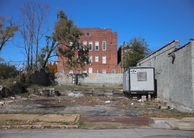From The Developing Economist VOL. 3 NO. 1The Effect of a 311 Vacant Building Call on Crime RatesVII. ResultsResults from our full model specification are given in Table 6: Table 7 displays displays a regression to determine if there is a difference in effect when excluding the Loop. Table 8 displays a reduced form specification: Tables 9 and 10 display regressions with robust standard errors: Full SpecificationIt is immediately apparent that many of our controls appear to have an insignificant effect on the difference in crime rates. Boarded and Occupied HousesOne of the most interesting findings in this regression is that both the dummy for whether the property is boarded at the time of the service call and the dummy for whether it is being used by other individuals are insignificant. This runs in contrast to much of the literature and is somewhat counterintuitive. It would perhaps be expected that open or occupied buildings would exhibit greater reductions in crime rates by dispersing criminals from safe havens. One reasonable justification for why we do not observe this is selection bias. It could be that service calls are overwhelmingly made in cases where the vacant property has a direct negative impact on the surrounding neighborhood, particularly through being a magnet for criminal activity. Consider a scenario where the probability that a service call is made is some increasing function of the number and severity of crimes surrounding the property. In particular if there is some threshold of crime incidence past which the probability of someone reporting the property increases dramatically, there may be little difference between crime rates for properties that are boarded versus open. Due to the selection bias in both scenarios crime might be comparable and building rehabilitation similarly beneficial. The same holds true for occupied houses versus ones that are not being used. Another possible explanation for the insignificance of whether the property being used by other individuals follows from the broken window theory. It could be that the existence of vacant properties that people can enter freely is emblematic of general disorder in the surrounding area. In particular, it might be that in such cases dispersing people from the vacant property fails to reduce crime rates overall because there may be other safe havens in the area where they can conduct illegal activity. Alternatively, it could be the use of a property by other individuals is a sign of serious neglect by the owner and could be correlated with greater delay and delinquency in rehabilitation efforts. A lack of cooperation from the owner could stunt efforts to secure the property. Finally, we note the summary statistics in table 1 again. There is not very high variance in these dummy variables, so more data may be needed to find significant results. Additionally a large number of values were missing. If the missing values are systematically correlated with other determinants of crime they could skew the results. FireThere does not appear to be a significant effect of whether the building was vacated due to fire on the change in crime rates. This conforms to our beliefs that the effects were theoretically ambiguous. Demographics and Other Block Group CharacteristicsPopulation, the percentage of black residence, the gender ratio, and the number of housing units on the block were all insignificant. There is little justification to believe these variables should drastically lead to changes in crime rates following a service call in one direction or the other, particularly after accounting for income. We later consider a model where several of these factors are removed from the regression in order to reduce the variance of key estimators. Median IncomeWe find that median income is nearly significant at the 5% level and the coefficient is positive. A higher median income could possibly leads to an increase in the post-call crime rate relative to the pre-call crime rate. This could be because higher income regions exhibit less crime in general, so the returns on rehabilitation are lower. However, the results are ambiguous. Difference in Crime in the Community AreaAs expected, the difference in crime in the community area between the post-call and pre-call periods has a significant effect on the difference in the vicinity of the vacant property. An increase in the signed difference in total crimes in the community area by 100 leads to an increase in the expected difference around the property by :857 crimes. Difference in Mean Temperature Between the Time PeriodsThe difference in mean temperature also a has a significant effect. A higher mean temperature in the post-call period relative to the pre-call period leads to a higher crime rate in the post-call period relative to the pre-call period. This is consistent with findings in the literature (Field 1992). An increase in the difference by 10 Celsius degree leads to an increase in the signed difference in crime rates by :405 crimes. Constant termThe constant term is insignificant. After accounting for other factors there does not appear to be a significant difference in the post-call period and the pre-call period. This suggests that the city's response to vacant property service calls is either inadeuqate or that rehabilitation of vacant properties has little effect on crime rates. However, we note that many of the variables in the model were insignificant, so confidence intervals and significance tests may not be accurate. We consider several reduced form models to reduce the variance in our coefficients. Still, these results are particularly intriguing because of the presence of selection bias. The vacant properties in our sample probably have greater negative impacts on communities on average than the typical vacant or abandoned property, and even in these cases the city's response does not seem to reduce crime rates by a substantial amount in the full model specification. Differences across Police DistrictsWe ran a regression under the full specification with added indicators for each police district. We examine whether the difference in crime rates varies by police districts. The excluded police district in the regression is district 1, which contains the Loop and downtown area. Nearly every police district is significant, but their confidence intervals all overlap. This suggests that the change in crime rates resulting from a service call in the loop area is significantly different than the change in crime rates in all other areas of Chicago. In particular, the signed difference in crimes in the Loop is roughly two crimes greater than in every other part of Chicago. This likely because the overwhelming number of properties in the Loop are high-rises and there is quite a bit of traffic and activity in the streets, so it is less likely a vacant building would become a safe haven for criminal activity. This seems to have little impact on our full model specification because only a small number of service calls occur in the Loop. Running the full specification again without the Loop leads to nearly identical results except that median income is no longer close to significant. The results are shown in Table 7. It stands to reason that excluding calls in the downtown region would have a significant impact on the median income coefficient since incomes in the Loop are on average much higher than in other parts of the city. Reduced Form ModelWe next consider models where we exclude the demographic indicators that had an insignificant effect on the change in crime rates. Removing these variables should decrease the variance in our estimates. Table 8 shows the regression results when we exclude population, the percentage of black residents in the block group, the gender ratio in the block group, median income, and the number of housing units. We observe that the constant term is now significant. In the post-call period there is a mean reduction in crime rates of approximately :153 crimes compared to the pre-call period. This is rather small relative to the mean crime rates for each period, which is around 20. These results change very little if we exclude the Loop. HeteroskedasticityWe use a Breusch-Pagan test to check for heteroskedasticity in our full model specification. The test is barely insignificant at the 5% level. We run the model with robust standard errors and display the regression results in Table 9. We note little difference in results. Table 10 shows the reduced form model regression results with robust standard errors. VIII. DiscussionWe note some limitations of our model. We do not account for other potential vacant properties in the vicinity of the property for which a service request is made. The presence of other vacant properties likely has a significant impact on the change in crime rates. If there are many other vacant properties in the vicinity it may be less likely that crime will be dispersed from the area because there are other safe havens where individuals can evade supervision. If this is the case rehabilitation will have less of an impact. Furthermore, rehabilitation could have greater positive externalities in regions with a lot of vacant properties, so the net reduction in crime could be greater. Including other service calls made in the same region and relevant time periods would be a very imperfect proxy to account for these effects because it fails to include all vacant properties for which a service call is not made. Further, the vacant properties it does include also face inspection and rehabilitation, so the interpretation of the coefficients is somewhat unclear and likely not entirely relevant to addressing our concerns. Another consideration is the choice of bandwidth parameters and the kernel function in estimating crime rates. Determining appropriate bandwidths nearly always poses challenges. There may be time frames that are more appropriate for capturing the effect of a service call, and there may be geographic regions better suited to measuring the impact on crime of a service call. Similarly there may be kernel functions more appropriate for modeling this problem than a boxcar kernel. There could conceivably be value in weighting crimes closer in time and space to the service call more heavily. Greater experimentation with these parameters is an potential area for further research. Finally, we again note the selection bias in our results. It is unclear to what extent inspection and rehabilitation elicited by service calls is representative of the rehabilitation process in general. Inspections based on property rate delinquency could be systematically different. Examining these effects in such cases would be an interesting avenue for further research. IX. ConclusionA substantial body of literature suggests that the presence of vacant properties induces greater crime in a region. However, there is little research into the success of city efforts to rehabilitate vacant properties in order to make them less susceptible to crime. We analyze the change in crime rates between the time period before a service call is made to the city to inspect a property and the time period after the call is made to determine the effect of rehabilitation on crime rates. We show that the rehabilitation has little effect on crime rates. This raises the question of why there is not a greater reduction in crime rates as a result of a service call being made. Two possibilities are that the city's efforts for rehabilitation are inadequate or that rehabilitation does not have a significant effect on crime rates for properties for which a service call is made. The latter explanation does not seem to be wellsupported by literature, which for instance shows that crime is much lower near boarded vacant properties than near unboarded vacant properties (Spelman 1993). One possibility is that for most service calls rehabilitation is not necessary at all, but it seems unlikely that there would be a large number of service calls for properties that pose no danger. Another possibility is that the process of rehabilitation takes far longer than the time period we consider due to noncompliance from property owners. This is certainly a possibility, but given the rights the city has to force rehabilitation on properties that pose immediate danger, we expected to find greater significance in our results. Finally, it could be the case that the resources of the city are too strapped to adequately deal with the large number of service requests. This is perhaps the most plausible explanation for why we do not observe greater reductions in crime rates. While our results provide a first step in analyzing the success of municipal governments in addressing the problem of vacant properties, there is certainly further research needed both to verify our results and determine potential causes for our findings. Further inquiry into rehabilitation of vacant buildings is invaluable for determining the best ways for cities to allocate resources to fighting crime. AppendixFigures and PlotsFigure 2: This plot shows the number of 311 service requests for vacant and abandoned properties for each month included in our study. Figure 3: Map of the community areas and police districts in Chicago. Retrieved from the Chicago Police website. Figure 4: An example illustrating the dimensions of the region around a vacant property we use to compute crime rates. Figure 5: A plot of the density of service requests for vacant and abandoned properties around Chicago over the time period of our study. Figure 6: A plot of the density of crime incidence around Chicago over the time period of our study. References
Suggested Reading from Inquiries Journal
Inquiries Journal provides undergraduate and graduate students around the world a platform for the wide dissemination of academic work over a range of core disciplines. Representing the work of students from hundreds of institutions around the globe, Inquiries Journal's large database of academic articles is completely free. Learn more | Blog | Submit Latest in Criminology & Criminal Justice |





























